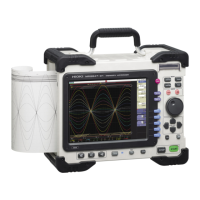13.1 Overview and Features
207
13
Chapter 13 FFT Function
FFT analysis can only be used with the FFT function.
The FFT (Fast-Fourier Transform) functions provide frequency analysis of input signal data.
Use these functions for frequency analysis of rotating objects, vibrations, sounds and etc.
For details, refer to "Appendix 5 FFT Definitions"(
p.A15).
Analysis can be performed on data as it is being measured, on pre-existing analog waveform data previ-
ously acquired with the Memory function, and on data output from waveform calculations.
When using Model 8968 High Resolution Unit equipped with an anti-aliasing filter, the cut-off frequency
can be automatically set by linking with the frequency range setting.
Major Features
•FFT analysis frequency range: 133 mHz to 8 MHz
•FFT Analysis Modes (16 types)
* Not available when using external sampling.
For phase spectra, only the required phase information is highlighted and displayed.
See:"13.3.8 Emphasizing Analysis Results (phase spectra only)" ( p.219)
so, when performing FFT analysis with the instrument connected to a sound level or vibration meter, scal-
ing by dB can be set from the Channel Settings screen if you want to read values directly in calibrated
units of measurement.
See:"Scaling" ( p.226)
Refer to the "17.2.4 FFT Function" ( p.299) for FFT function specifications.
FFT Function
Chapter 13
13.1 Overview and Features
• Storage Waveform • Cross-power Spectrum
• Histogram • Impulse Response
• Linear Spectrum • Coherence Function
• RMS Spectrum • Phase Spectrum
• Power Spectrum • Auto-correlation Function
• Power Spectrum Density* • Cross-correlation Function
• LPC analysis (Power Spectrum
Density)
*
• 1/1 Octave Analysis*
• Transfer Function • 1/3 Octave Analysis*
To suppress the effects of aliasing distortion
We recommend using Model 8968 High Resolution Unit that are equipped with anti-aliasing filtering
to suppress the effects of aliasing distortion when sampling.
See: Aliasing Distortion and Anti-Aliasing Filters
"Appendix 5 FFT Definitions"(
p.A15)

